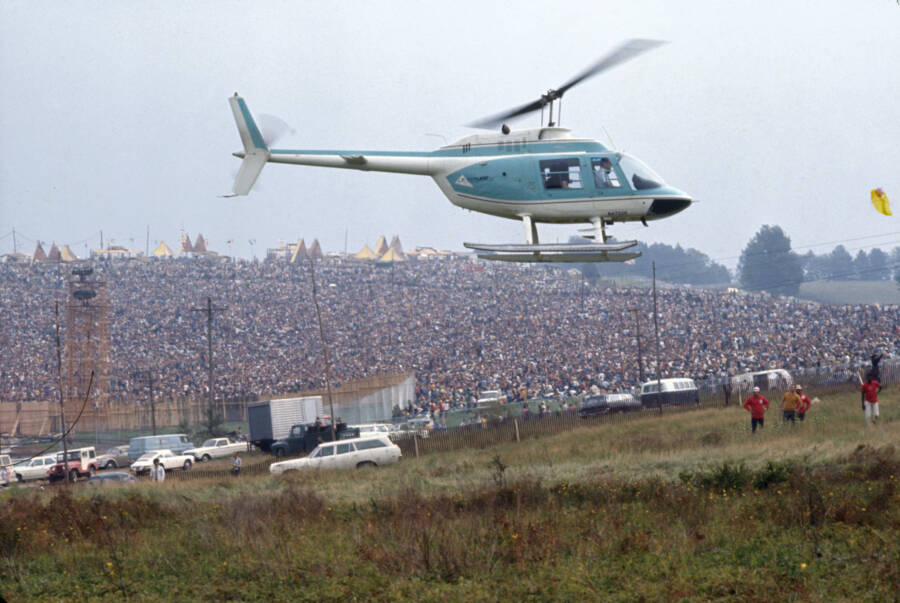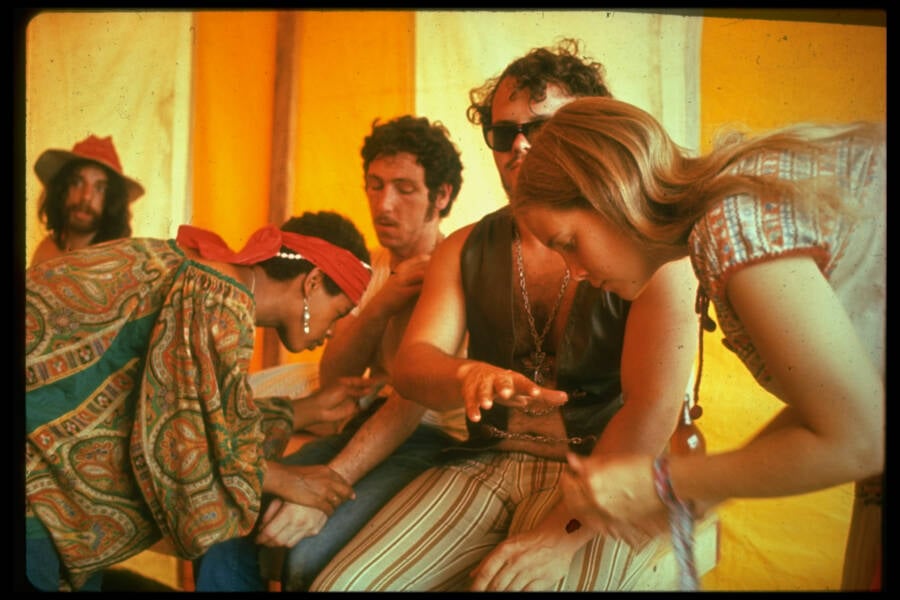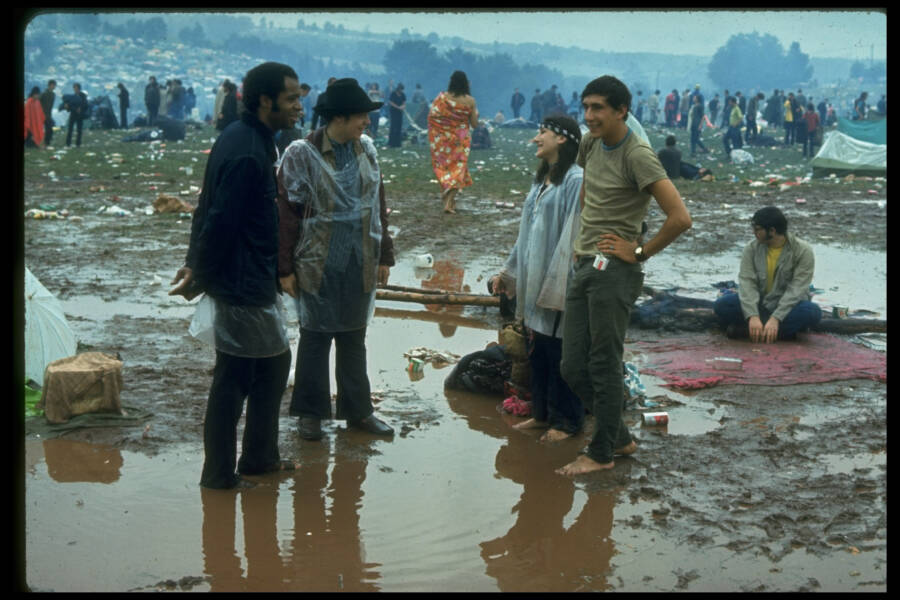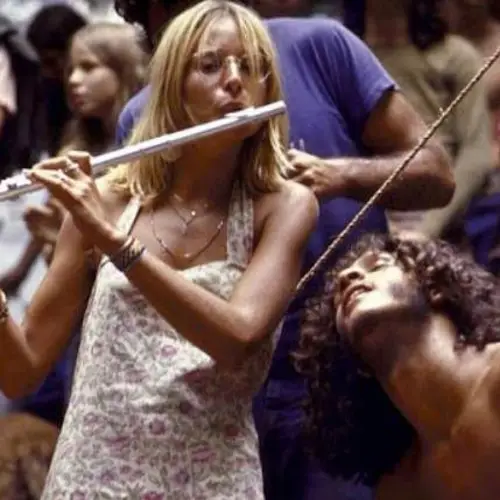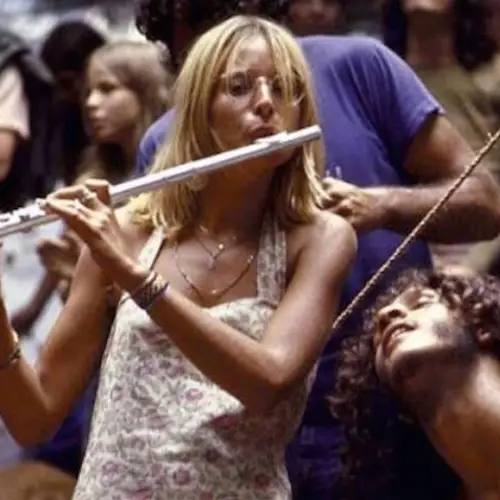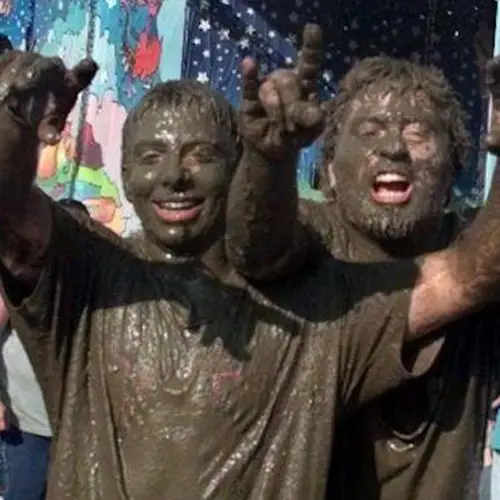Fifty years ago this summer, half a million hippies, beatniks, and long-hairs descended upon upstate New York for the Woodstock music festival. The world would never be the same.
Max Yasgur probably never imagined that he would host at least 400,000 people on his 600-acre dairy farm in Bethel, New York. But for three straight days in August 1969, his bucolic pastures became a hub for sex, drugs, and rock ‘n’ roll during Woodstock — the music festival that changed the world.
The Woodstock music festival is not only an icon of American musical history but of American history itself. In the last month of the last summer of the 1960s, hundreds of thousands of hopeful, optimistic young people came together and define their generation and their era as a whole.
But as iconic as this festival remains 50 years later, its story is widely misunderstood to this day. For starters, even though it’s known as the Woodstock festival, Yasgur’s dairy farm wasn’t even walking distance from the town of Woodstock — it was 43 miles away.
So how did the most famous music festival in history get misnomered? Who organized it, and what myths about that weekend were mere legend — and which were true?
This is the complete, true story of what unfolded in upstate New York during that historic weekend in August 1969.
Organizing Woodstock Music Festival
The Woodstock music festival was the brainchild of four men in their 20s looking for a viable business opportunity. Since musical innovation blossomed in the 1960s, they wanted to harness its popularity on a grand scale.
John Roberts, Joel Rosenman, Artie Kornfeld, and Michael Lang had an admirable collective résumé to make their attempt viable. Lang had already organized the Miami Music Festival in 1968, and successfully so. Kornfeld was Capitol Records’ youngest vice president ever, while Roberts and Rosenman were young entrepreneurs out of New York City.
The four young friends had a genuine appreciation for music; their music festival was more than a cynical attempt to cash in on popular music. To make the mission official, they formed Woodstock Ventures, Inc. The next step was finding talent to sign on.

Wikimedia CommonsCreedence Clearwater Revival was the very first act to sign on, lending, well, credence to the Woodstock music festival.
When Creedence Clearwater Revival became the first act to agree to perform in April 1969, Woodstock Ventures landed all the credibility required to curate a respectable roster of contemporary artists. Though the line-up was growing into an impressively curated batch, securing the venue itself was becoming a problem.
The original plan was to hold the Woodstock festival at Howard Mills Industrial Park in Wallkill, New York, which the organizers leased for $10,000.
“The vibes weren’t right there. It was an industrial park,” Roberts later recounted. “I just said, ‘We gotta have a site now.'”
The prospect of having thousands of hippies at the height of the counterculture movement invade their little town, however, was too troubling for Wallkill officials. The town officially backed out on July 15 and even protected themselves legally by passing laws — including a portable toilet ban — that made it virtually unfeasible to host a festival there.
With the original venue off the table, Woodstock Ventures scrambled for an alternative — but none were compatible with their vision.
One month before the historic, three-day concert, the four young entrepreneurs found salvation in the form of a 49-year-old dairy farmer. Max Yasgur graciously allowed them to rent part of his property. The White Lake area in Bethel, surrounded by the Catskill Mountains, turned out to be exactly what they needed.
Problems Plague The Preparations
The history of Woodstock is riddled with chaotic problems and spontaneous solutions. Once the venue and talent were locked in, logistics became the primary concern. A music festival requires infrastructure, security, and regulation — and Woodstock struggled with all three.
In fact, essentials like ticket booths, gates, and fencing to cordon off the grounds were nowhere near completed when the masses began trickling in. Bathrooms, concession stands, and a pavilion for the professional performers were likewise utterly lacking before showtime.
Lang later explained that though it might’ve seemed like an oversight, the reasoning was that he and his colleagues felt that other elements — like food and quality entertainment — were more important to guarantee.
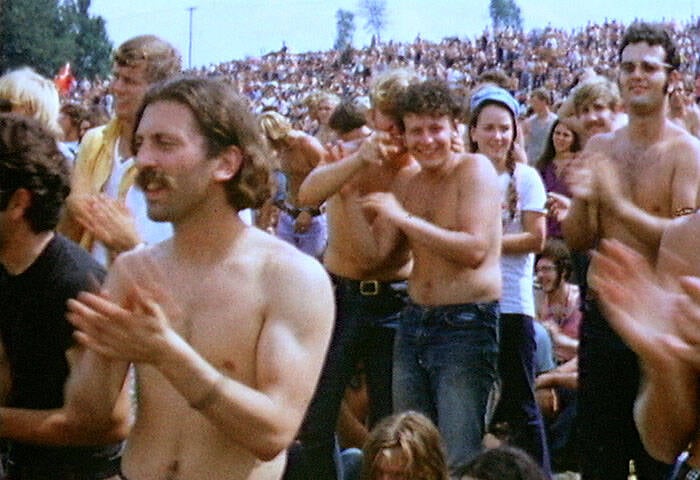
Wikimedia CommonsAfter a grueling commute through jammed highways and setting up shop on Yasgur’s farm, concertgoers finally got to celebrate the first day of the 1969 Woodstock music festival on August 15.
“You do everything you can to get the gates and the fences finished — but you have your priorities,” he said. “People are coming, and you need to be able to feed them, and take care of them, and give them a show. So you have to prioritize.”
Their solution was both financially unwise and extremely heartfelt. There was no efficient way to charge attendees, so the four young businessmen decided to do the only thing they could: make Woodstock free.
They lost out on untold amounts of money, of course (which they made up for in part by producing an Oscar-winning documentary of the festival), but their festival has lingered in the minds of millions for half a century — something that arguably would never have happened if they stuck with the original attendee cap of 50,000 and delayed ticketing. But they ended up welcoming far, far more than 50,000 — and, in the process, made history.
The Woodstock Festival Begins
Woodstock Ventures pre-sold more than 100,000 tickets, and by August 13, at least 50,000 people were already camped out on the Yasgur property. The final, official numbers of attendees vary greatly and range somewhere between 400,000 and one million people.
Though some had to be evacuated, floods ravaged the campgrounds, and two people lost their lives, the sheer pandemonium possible with such a mass of free-spirited people ultimately turned out to be far less anarchic than skeptics would've guessed.
"It was big. You knew it was a really momentous and special thing — and I was nervous. The fact that freeways were all clogged for 50 miles around was like, 'Wow, that's pretty unusual.' We were taken by helicopter and dropped at the Holiday Inn and allowed to sleep a little bit, and from there we were taken by helicopter, this shaky old World War II thing that I was also really nervous about; only two of us at a time could fit in it. We arrived in daylight and saw all these people and it was like, 'Oh my god...' Once I was on the ground and I looked around I was just nervous the whole time I was there, because with half a million people there were no rules." - John Fogerty of Creedence Clearwater Revival, 2009."
The lack of sanitation, food, and water was certainly an issue, but Woodstock was a famously peaceful affair. Though political assassinations and the Vietnam War were in the news, the young counterculture generation present at Woodstock was eager to bond, surround itself with music, and unite in peace.
"These people are really beautiful," said the festival's chief medical officer, Dr. William Abruzzi. "There has been no violence whatsoever, which is really remarkable for a crowd of this size."
Many attribute this impressive serenity to the ubiquitous use of psychedelics and the "make love, not war" mantra of the 1960s counterculture. It's no surprise that many attendees birthed children some nine months later.
The highways and streets leading into town were so jam-packed that traffic essentially came to a halt. Some people simply left their cars on the road and headed to camp on foot, while others partied in, on, or around their vehicles.
A little after 5 p.m. on August 15, 1969 — once hundreds of thousands of fans made it to the grounds and settled in — Woodstock finally began. It would become the most celebrated music festival in history.
"The Most Courteous, Considerate And Well-Behaved Group Of Kids"
The two fatalities at Woodstock were unfortunate accidents. One teenager was run over by a tractor by an unsuspecting driver who didn't notice a sleeping concertgoer in front of the vehicle. The other died of a drug overdose.
Two deaths in a group of at least 400,000 people, however, could almost be categorized as a success. The medical tent was staffed by volunteer doctors, EMTs, and nurses, though most incidents were minor and ranged from food poisoning and wounded bare feet to fatigue.
It was reported, however, that eight women underwent miscarriages during the three-day festival. Woodstock's organizers also hired the California hippie commune the Hog Farm to establish a playground for the kids of concertgoers, as well as a free food kitchen and a tent for those who might've taken a few too many psychedelics to calm down.
Hog Farm leader Wavy Gravy would spray seltzer water and throw pies at people overstepping their boundaries.
"We're the hippie police," Gravy announced as he stepped off the plane four days before the festival began.
In terms of security, only about 12 law enforcement officers were in charge of policing an estimated half a million people.
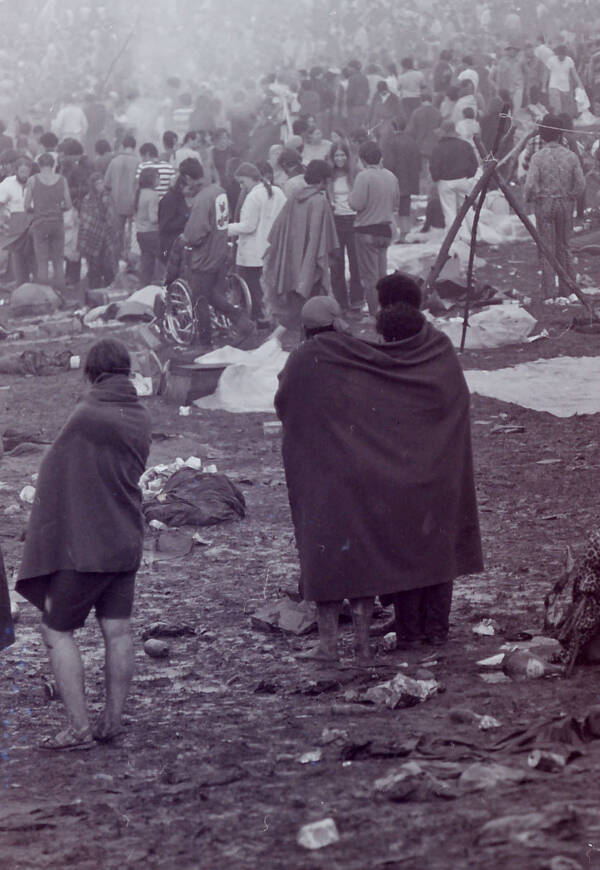

Wikimedia CommonsThere was virtually no police or infrastructure at Woodstock besides a few infirmary, food, and relaxation tents and areas. Yet concertgoers braved the elements for three days and caused no violence.
Nonetheless, the mob of hippies who took over the town made a remarkably positive impression on its citizenry, including the police.
"Notwithstanding their personality, their dress, and their ideas," said the head of Monticello Village Police Department near Wallkill, "they are the most courteous, considerate and well-behaved group of kids I have ever been in contact with in my 24 years of police work."
"When our police cars were getting stuck," another cop confessed, "they even helped us get them out. It was really amazing. I think a lot of police here are looking at their attitudes."
Of course, Woodstock would be nothing but a massive three-day summer camp without the actual music — and there were some legendary acts on stage over those three days in August. From promising local talent to globally-adored icons, the lineup was one to remember.
Musical Legends Take The Stage At Woodstock 1969
Thirty-two acts performed at Woodstock, many of them iconic, with an open mic on the Free Stage available to attendees ready to show their talent off to each other. The first day began on Friday, August 15 around 5 p.m. when Richie Havens took the stage. As he described it in 2009:
"I was supposed to be fifth on stage, and no one at the whole festival went on when they were supposed to. I came in on one of those glass bubble helicopters and saw Tim Hardin under the stage, sort of playing by himself. I knew he wasn't going on first. I didn't want to, either, but I had the least number of instruments, so...I thought, 'God, three hours late. They're gonna throw beer cans at me. They're gonna kill me.' Fortunately the reaction was 'Thank God somebody's finally going to do something.' They were happy.
I was supposed to sing for 40 minutes, which I did, and I walked off the stage and the people were great, and then (the organizers) said, 'Richie, four more songs?' 'OK.' I went back on and they were still clapping, so I sang four other songs, went off again, then I hear, 'Richie, four more songs?' They did that to me six times. Two hours and 45 minutes later I'd sung every song I know."
His two-hour set was followed by Indian spiritual master Satchidananda Saraswati performing an unscheduled blessing for the crowd. This was followed by sets from Sweetwater, Bert Sommer, Tim Hardin, Ravi Shankar, Melanie, and Arlo Guthrie.
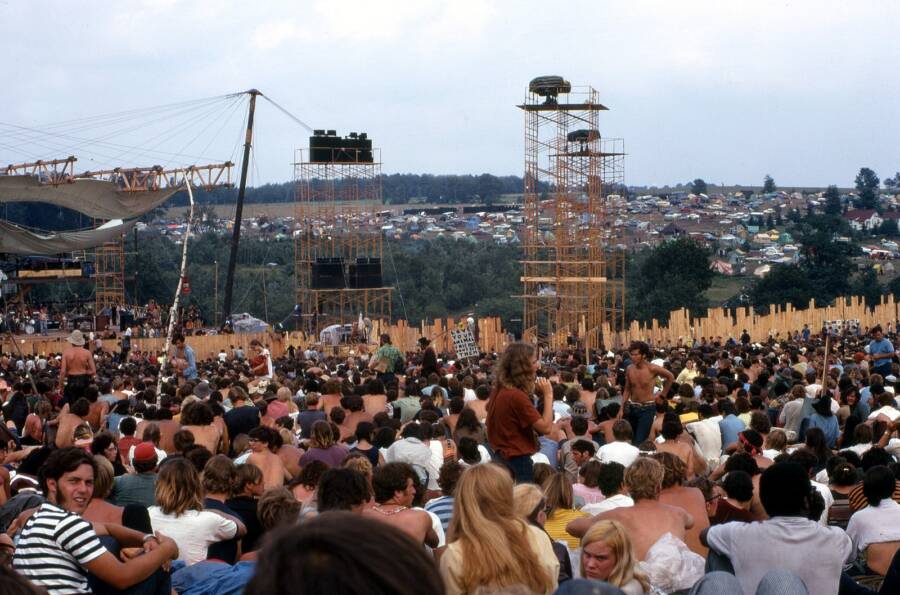

Wikimedia CommonsThe crowd celebrates Joe Cocker kicking off the second day of the 1969 Woodstock music festival around 2 p.m. on Saturday, August 16.
Joan Baez, who was six months pregnant, was the last act of the night. The venerated folk singer famously finished her set around 2 a.m. on August 16 as the pouring rain washed away the first day of the Woodstock music festival.
"It was a once in a lifetime thing for me. (Playing on the free stage) was a riot. Whoever was officially taking names and putting people in order didn't recognize me. I was just one of the lineup. I think I just gave my name as Joan. I went out on the stage and I'm not sure what I sang, but I remember this guy at the top of the hill, in the back...with no clothes on and flowers in his hair and a long beard. And he started to dance through the crowd toward the stage. So I just cut one of the songs so I could bow politely to him and leave before he made it to the stage and got up there with me." — Joan Baez, 2009.
"The whole thing is a gas," said one long-haired concertgoer nick-named Speed, according to The New York Times. "I dig it all, the mud, the rain, the music, the hassles."
The Second Day Dawns And The Crowd Grows
Though the first day's lineup was impressive, things got even more spectacular once the sun rose on the second day.
"It was like witnessing an ocean of hair, teeth, eyes, and hands. If you closed your eyes, you could forget the impact of seeing a moving ocean of flesh. Then you could just feel the sound, which had a different kind of reverberation when it bounced off the people and came back at you....I remember seeing Jerry Garcia; as soon as we landed, he was already playing his guitar on the hill with this beautiful, blissful smile on his face." — Carlos Santana, 2009.
Shortly after noon that Saturday, many musicians took the stage: Quill, Country Joe McDonald, Santana, John Sebastian, Keef Hartley Band, The Incredible String Band, Canned Heat, Mountain, The Grateful Dead, Creedence Clearwater Revival, Janis Joplin and The Kozmic Blues Band, Sly and the Family Stone, The Who, and Jefferson Airplane.
"When we left Los Angeles we flew all night to get to Woodstock. We had heard there were 200,000 people already there, which was amazing, and by the time we got there, everything had changed. It was no longer the 200,000; it was out of control as far as we could tell. We didn't know what to expect, but we went in there...in a little helicopter, sort of hanging out on the pontoon of the helicopter. And backstage we were having a totally different experience than the audience. There was a lot of creature comforts — there was friends, there was food, there was good smoke, booze, whatever. We weren't experiencing the same environment that the rest of the people were.
Then when we got on stage, we didn't know there were 500,000 people there. It was pitch black. After the first few songs, we still weren't sure if there was anyone there; it was three in the morning and it was getting pretty quiet. People had had a fairly long day. And then some guy way the hell out there yells, 'We're with ya!,' and we were like, 'OK, well, that's the guy the concerts for,' and on we played. The next day we played for 5,000 people somewhere, and it started to dawn on us what we'd just been at, that we'd probably never see anything like that or experience an event like that again." — Stu Cook of Creedence Clearwater Revival, 2009.
The Final Day Of The 1969 Woodstock Music Festival
Day two ended at 9.45 a.m. on Sunday, August 17 — a little more than four hours before Joe Cocker kicked off day three. He was followed by Country Joe and The Fish; Ten Years After; The Band; Johnny Winter; Blood, Sweat & Tears; Crosby, Stills, Nash & Young; Paul Butterfield Blues Band; Sha Na Na; and Jimi Hendrix.
"It was kind of nerve-wracking for us. It was only our second show. Everybody we knew or cared about in the music industry was there. They were heroes to us — The Band and Hendrix and The Who...They were all standing behind us in a circle, like, 'OK, you're the new kids on the block. Show us...'" — David Crosby, 2009.
https://www.youtube.com/watch?v=AqZceAQSJvc
All in all, those who performed at Woodstock in 1969 successfully enshrined themselves in music history. Those who attended as mere fans, too, have had a story to tell that only a fraction of the world can claim.
But there were a few other acts who declined to perform, and likely regretted that decision for the rest of their lives. Among them were Simon & Garfunkel, Joni Mitchell (who later wrote the song "Woodstock" to commemorate the historic gathering), Led Zeppelin, Bob Dylan, The Byrds, The Moody Blues, The Doors, Roy Rogers, John Lennon, Chicago Transit Authority, and The Rolling Stones.
For the latter, of course, the Altamont Speedway Free Festival that December would provide them with a similar opportunity. But that concert was famously plagued by stabbings, caused by a faction of the Hells Angels who worked security.
But regardless of Altamont or any other gathering, there was never anything like Woodstock before — or since. The times were different; one massive festival could become the focal point of an entire generation.
https://www.youtube.com/watch?v=MwIymq0iTsw
And, fittingly, Woodstock's finale featured one of its most celebrated performers: Jimi Hendrix.
While Hendrix's set at Woodstock has arguably been the single most famous and widely viewed part of the festival in decades since, the fact that his set was delayed due to rain until Monday morning is a lesser-known part of his legendary appearance.
When Hendrix got to the stage at 9 a.m. on Monday morning, there were only about 30,000 people left in the audience. The festival had only been scheduled to last until Sunday night, and many people had to get back to their lives.
But leaving Bethel, New York wasn't as easy as people thought. With the same traffic issues that confronted attendees during their commute in, the same highways and roads clogged up and jammed in a matter of minutes.
For Yasgur and the four young festival organizers, of course, the event was far from over. A monumental cleanup session awaited — one which took days, cost tens of thousands of dollars, and required bulldozers to complete.
Woodstock Ever After
This world-renowned, historically significant, massive, three-day pinnacle of 1960s counterculture momentum would never have happened if it weren't for Max Yasgur and his supportive wife, Miriam. For him, it was all worth it — and instilled in him a sense of optimism about the young generation he'd welcomed onto his farm.
"You've proven something to the world," he told the audience on the last day. "That a half a million kids, and I call you kids because I have children who are older than you are, a half a million young people can get together and have three days of fun and music and have nothing but fun and music. And God bless you for it!"
Of course, The New York Times begged to differ in its coverage following the festival. The editorial section called the three-day event "an outrageous episode," and asked, "What kind of culture it is that can produce so colossal a mess?"


Wikimedia CommonsMax Yasgur told the massive crowd on his property that they proved to the world that their generation could come together in droves to celebrate and not cause the kind of mayhem that older generations anticipated.
And now, 50 years later, a "mess" is hardly the legacy of Woodstock. Instead, it's a historic, watershed moment that represents the zenith of a particular culture and captures a specific moment of time that will never be replicated in quite that way ever again.
Today, after a half-century, you can go up on a hill at the Bethel Woods Center for the Arts and stand on the hallowed ground where the 1969 Woodstock festival took place. The center opened in 2006 with an outdoor concert venue and a 1960s museum.
Some of the acts who performed at the Woodstock 1969 have returned to play shows in the decades since. Some died before they got the chance. Generations have come and gone since that one magnificent weekend in the summer of 1969.
For most of us, it's always been mere legend — one we couldn't see, touch, or be a part of. But for a few hundred thousand lucky people, it was the greatest moment of their lives — a moment that left a mark on history that remains as indelible as ever 50 years later.
After exploring the 1969 Woodstock music festival, learn everything there is to know about hippies and the Summer of Love.




